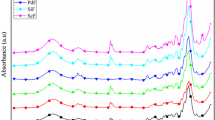Abstract
The main focus of this study is to investigate the influence of functional groups of cellulose and its derivatives on properties and morphology of alumina materials obtained by template synthesis. Cyanoethyl-, amidoethyl- and carboxymethylcellulose were synthesized from bleached softwood pulp and they were used as templates for alumina materials preparation. By means of methods of scanning electron microscopy and nitrogen physical sorption it was shown that properties and type of functional groups of template can influence on the morphology and textural characteristics of obtained ceramic materials. The alumina specimens that obtained from cyanoethyl-, amidoethylcellulose have thicker fibers and two times increased surface area in comparison with alumina obtained from initial cellulose but the one formed by carboxymethylcellulose have thin alumina fibers and three times decreased surface area. Thus, by regulating properties and type of template it is possible to obtain ceramic materials with desired properties and morphology.
Similar content being viewed by others
References
G. Motz and R. K. Bordia, in “Handbook of Textile Fibre Structure: Natural, Regenerated, Inorganic and Specialist Fibres” (S. Eichhorn, J. W. S. Hearle, M. Jaffe, T. Kikutani Eds.), Vol. 2, pp.378–424, Woodhead Publishing Cambridge, 2009.
C. C. Barry and N. M. Grant, “Ceramic Materials. Science and Engineering”, 2nd ed., pp.359–379, Springer New York, 1987.
R. W. Rice, “Ceramic Fabrication Technology”, pp.252–295, CRC Press New York, 2002.
T. M. Ulyanova, L. V. Titova, O. P. Chudakov, and V. L. Evtuhov, Mech. Compos. Mater., 35, 179 (1999).
A. N. Shigapov, G. W. Graham, R. W. McCabe, and H. K.Plummer Jr, Appl. Catal. A-Gen., 210, 287 (2001).
W. W. Liu, C. F. Zeng, L. X. Zhang, H. Wang, and N. Xu, Mater. Chem. Phys., 103, 508 (2007).
R. Q. Sun, L. B. Sun, Y. Chun, Q.-H. Xu, and H. Wu, Microporous Mesoporous Mat., 111, 314 (2008).
S. R. Hall, “Biotemplating: Complex Structures from Natural Materials”, pp.28–59, World Science Publisher Singapore, 2009.
Y. Qiu and J. Yu, Solid State Communications, 148, 556 (2008).
G.-M. Kim, S.-M. Lee, M. Knez, and P. Simon, Thin Solid Films, 562, 291 (2014).
T. Wang, S. Kong, L. Chang, and C. Wong, Ceram. Int., 138, 6783 (2012).
M. Nidhin, R. Indumathy, K. J. Sreeram, and U. N. Balachandran, Bull. Mat. Sci., 31, 93 (2008).
D. Klemm, B. Heublein, H.-P. Fink, and A. Bohn, Angew. Chem.-Int. Edit., 44, 3358 (2005).
Y. Nishiyama, P. Langan, H. Chanzy, J. Am. Chem. Soc., 124, 9074 (2002).
D. Klemm, H.-P. Schmauder, and T. Heinze in “Biopolymers: Biology, Chemistry, Biotechnology, Applications” (E. Vandamme, S. De Baets, and A. SteinbüchelEds.), pp.271–319, Wiley VCH, Weinheim, 2002.
B. Volkert in “Cellulose Solvents: For Analysis, Shaping and Chemical Modification” (T. F. Liebert, T. J. Heinze, and K. J. EdgarEds.), pp.319–341, American Chemical Society Washington, DC, 2010.
A. Charmot, P.-W. Chung, and A. Katz, ACS Sustain. Chem. Eng., 2, 2866 (2014).
L. M. Manocha, J. Valand, and S. Manocha, Int. J. Nanosci., 5, 425 (2006).
J. Qiang, Y. Wan, L. Yang, and Q. Cao, J. Nano Res., 23, 96 (2013).
D. Bandera, J. Sapkota, S. Josset, C. Weder, P. Tingaut, X. Gao, E. J. Foster, and T. Zimmermann, React. Funct. Polym., 85, 134 (2014).
H. Sosiati, M. Muhaimin, P. Abdilah, D. A. Wijayanti, Harsojo, and K. Triyana, AIP Conference Proc., 1617, 105 (2014).
E. Kaminska, Materials Research Society Symposium Proc., 462, 45 (1997).
M. Negishi and N. Aida, Text. Res. J., 28, 982 (1959).
N. Haleem, M. Arshad, M. Shahid, and M. A. Tahir, Carbohydr. Polym., 113, 249 (2014).
S. J. Greg and K. S. W. Sing, “Adsorption, Surface Area and Porosity”, pp.111–190, Academic, London, 1982.
R. T. O’Connor in “Cellulose and Cellulose Derivatives” (N. M. Bikales and L. SegalEds.), Part IV, pp.54–91, Wiley-Interscience, New York, 1971.
G. C. Daul, R. M. Reinhardt, and J. D. Reid, Text. Res. J., 25, 246 (1955).
R. F. Jr. Schwenker, L. R. Jr. Beck, R. K. Zuccarello, Am. Dyestuff Rep., 53, 817 (1964).
W. Tsuji, T. Nakao, K. Ohigashi, K. Maegawa, N. Kobayashi, S. Shukri, S. Kasai, and K. Miyanaga, J. Appl. Polym. Sci., 32, 5175 (1986).
T. Kondo, J. Polym. Sci. Part B: Polym. Phys., 35, 71 (1997).
A. M. Zhivkov in “Cellulose-Fundamental Aspects” (T. van de Ven and L. Godbout Eds.), pp.197–226, InTech, Rijeka, 2013.
D. H. Everett, Pure Appl. Chem., 31, 577 (1972).
Author information
Authors and Affiliations
Corresponding author
Rights and permissions
About this article
Cite this article
Martakov, I.S., Krivoshapkin, P.V., Torlopov, M.A. et al. Application of chemically modified celluloses as templates for obtaining of alumina materials. Fibers Polym 16, 975–981 (2015). https://doi.org/10.1007/s12221-015-0975-z
Received:
Revised:
Accepted:
Published:
Issue Date:
DOI: https://doi.org/10.1007/s12221-015-0975-z




